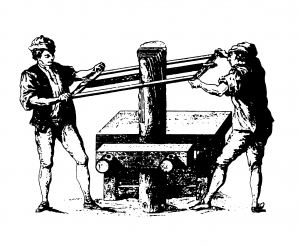Pharaos master joiners
invent the veneer, more than 4000 years ago.
1500 befor Christ. Egypt needs wood, many wood. Lumber for houses and fine woods for inlays in palaces and tombs. But wood is rare and as valuable as it rarely is.
Master carpenters cleverly split tree trunks. The results are high quality wood sheets, the first veneers.
In a country that has more sand and stone than forest, you have to learn to use the scarce raw material sparingly. Pharaos master joiners develop the technical skill to split the valuable logs.
Planing benches were still unknown by the Egyptians. They clamped the wood in a vice and worked it with saw, chisel or drill. Instead of the planer, the workpieces were smoothed with small axes and rubbing stones. For coarser work, axes sufficed. With the help of wooden pencils, they combined veneer sheets into plywood, individual pieces of furniture were mortised to make complete furniture. The Egyptians also already mastered the technique of bending wood with the help of steam.
The first veneers, high-quality wood sheets, each one unique, are created in laborious hand work. Wood sheet on wood sheet blends into visually attractive surfaces, in a unique beauty. Adhesives and wooden pencils hold the wood sheets on a base of simpler woods. Pharaos master joiners invent the veneer more than 4000 years ago. Archaeological discoveries show veneered furniture until 1500 befor Christ.
1500 anno domini
the furniture, how we it know, was born.
The veneer reached us via the Roman Empire and Greece. There was little attention for a long time. Carpenters are the only professional woodworkers until the 14th century. Cooper and wainwright follow as independent craft trades.
In the 15th century the wealthy society discovered the individual lifestyle. Previously firmly anchored cupboards and seatings now dissolve from the walls. The furniture, how we it know, is born. It becomes the object of representation and the domain of carpenters. Above all, the use of glue in the 17th century finally promoted the ascending technique of veneering.
The fear of wood scarcity exists even then. The excessive need for shipbuilding (for example for the Spanish Armada) causes a clear cut in Spain. The furniture production is moving away from the solid wood, towards the material-saving veneer.
Veneer carriers were highly regarded
But the carpenters have a hard time getting into the possession of the noble veneer, because they can not make it themselves. Only a few masters handle this technique. These are the “veneer carriers”, very specialized, highly paid craftsmen. They live preferably in the former commercial metropolises such as Vienna, London, Amsterdam or Paris.
Until the late 18th century veneer saw remains laborious hand work. Even making small quantities is very time consuming and causes too much waste. In the era of the Industrial Revolution, the first veneer saw machine was introduced in England in 1806. The first veneer factory in Germany was built in 1843 in Freiburg. Around 1890, the electric motor prevails. The basis of mechanical veneer production was created. Larger quantities are now inexpensive to produce.
Today veneers are used to achieve an infinite variety of colors and structures. Every tree, which is useable for veneer, can be disposed to nearly 100%. There is no more sustainable and economical use of wood.




